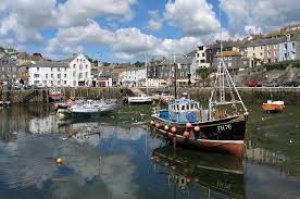


Much photographed picturesque fishing village
Web: www.mevagissey.net
Web: www.visitcornwall.com/destinations/mevagissey
The fishing village of Mevagissey is the very essence of a Cornwall which has remained true to its roots and embraced change only slowly. The village is located just five miles south of St. Austell along the B3273. The village nestles in a small valley and facing east. The inner and outer harbours are busy with a mixture of pleasure vessels and working fishing boats, the remains of a once major industry. However, tourism has supplanted fishing as the dominant industry in recent years. The population of the village was 2,015 at the 2011 census.
The name belongs to 6th century Irish missionaries. Mevagissey's labyrinth of tiny streets twist and turn past ancient dwarf buildings of cob and slate but inexorably for the twin harbours which are its nerve centre, a place to watch the fisherman land their catch and mend their nets as they have since John Trewollas built the first pier in 1430, it was rebuilt in 1774 and an outer harbour was added in 1888, but seriously damaged in a blizzard in 1891.
The Norman church was dedicated to St. Meva and Ida in 1259. The church is cruciform and some Norman work remains but the church was more or less rebuilt in the 15th century and became St. Peter's.
By the 19th century, the most important catch made by the fisherman was pilchard, some 40 million a year of which were salted in special cellars you can still see and packed into barrels for export to France and Italy.
The RNLI stationed a lifeboat at Portmellon in 1869 but in 1888 moved it to Mevagissey. It was kept afloat in the harbour for a few years but in 1896 was moved into a purpose-built concrete boat house. The following year a new boat, the James Chisholm, was installed. This operated until 1930 when the station was closed. A lighthouse was built on the southern quay in 1896.
Earlier still, some of the crew doubled as smugglers or privateers, but today their secondary role is to introduce visitors to inshore fishing for mackerel or deep-sea shark-hunts. The full range of fish in local waters can be seen at the Aquarium, converted from the old lifeboat house.
Mevagissey Museum which is full of local exhibits is housed in an old boat-building yard on the northern arm of the harbour. Mevagissey Aquarium is on the southern arm of the harbour.
Mevagissey had a power station built in 1895, powered by pilchard oil, which provided electricity for the lighthouse and surrounding streets.
Mevagissey is home to three Cornish holy wells. The Brass Well and Lady's Well are both situated in the manor of Treleaven, the other holy well is within the gardens of Mevagissey House, the old vicarage.
Mevagissey village centre consists of narrow streets with many cafes and shops aimed at the tourist trade. The outer areas are built on the steep slopes of the surrounding hillsides and are mostly residential.
The potter Bernard Moss used to run pottery business in the village, but has since retired.
Mevagissey is renowned for the soaring switchback walks along The Coastal Footpath that whet the appetite for its seafood or help to walk it off. From Polkirt Hill you can look out over the Medieval street plan, the fishing boats in the harbour and the yachts in the pool, to the golden sweep of Polstreath Beach and St. Austell Bay or south to the inlet that shelters Portmellon Cove and to the scenic coast path over Chapel Point to Gorran Haven.
The Heligan estate is located on the steep slopes above Mevagissey, albeit mostly in the adjoining civil parish of St. Ewe. The long term home of the Tremayne family, the estate is now best known as the location of the Lost Gardens of Heligan, a recently restored Victorian garden.
A park in Mevagissey is popularly named Hitler's Walk by locals. Local folklore attributes this naming to the 1930's use of the park by a local councillor who was perceived to have displayed petty authoritarian tendencies; while others say it was because the home guard would patrol there looking for invasion forces from Germany. The park was the subject of controversy and national news headlines in September 2005 when signs bearing the name were removed after complaints to Restormel Borough Council, and again in January 2015 after the Mevagissey Parish Council decided to reinstate them. Harvey Kurzfield of Kehillat Kernow described the decision to restore the signage as "outrageous and completely unfeeling" and urged Jewish people to boycott the village. In February 2015 it was reported that the council had dropped the plans to reinstate the signs.
Mevagissey is a popular location for film-makers and advertisers. It featured in The Next of Kin, 1942; Johnny Frenchman, 1945; Never Let Me Go, 1953; Dracula, 1979 and Bad Education, 2015.
There is a summertime ferry service across the bay to Fowey.
The town's Tourist Information Centre is at Hurley Books, 3 Jetty Street, PL26 6UH.
Andrew Pears (1766-1845) who invented the eponymous transparent soap in 1812, and lived here from 1789.
Mevagissey holds a Harbour Lights Festival in May which raises money for the Christmas Lights Festival in December.
Mevagissey Feast Week, a week of family fun, music, and floral dances through the streets, is held at the end of June.
Mevagissey Shanty Festival - Mid October
Gorran Haven Portmellon Dodman Point St. Ewe Mevagissey Lighthouse
Mevagissey Museum Pentewan Bosue Vineyard Polmassick Vineyard St. Austell Mevagissey Aquarium
Mevagissey Model Railway The Coastal Footpath The Lost Gardens of Heligan The Roseland Peninsula